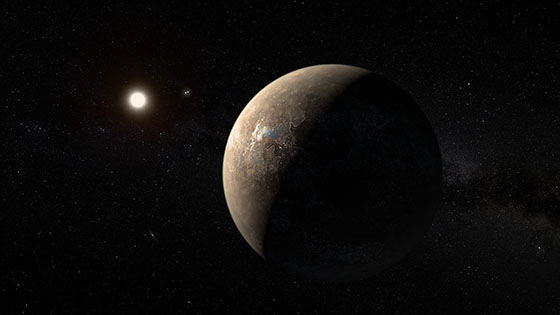
By ESO/M. Kornmesser - https://www.eso.org/public/images/ann16056a/,
CC
BY 4.0, Link
While it's neat that we're now discovering possibly earth-like exoplanets orbiting other stars, it's also rather frustrating to realize that we'll never be able to travel to any of them in any foreseeable future.
The closest exoplanet- Proxima Centauri b- is 1.3 parsecs distant, or 4.2 light years. A light-year is the distance that light travels in a vacuum in one Julian year (365.25 days). That puts our closest interstellar planetary neighbor 24,690,120,000,000 (24.69 trillion) miles away.
We don't have antimatter-powered starships that can circumvent Einstein's theory of special relativity, which prevents anything having mass from traveling at or faster than the speed of light. While some particularly arcane math suggests it might be possible to warp spacetime, we have no clue what technology would be necessary to do it.
I bring this up because an online acquaintance of mine believes these distant worlds could serve as our "plan b" if we render our home world uninhabitable. (Same guy believes Elon Musk's Mars ambitions are irrational.)
True, technology has saved our collective butts in the past, but come on, snap out of it. This ain't no Kessel Run scenario, Skippy. The only way to save Earth is to save Earth.
-----
About the above photo (from Wikipedia): Artist's impression of the exoplanet Proxima Centauri b shown as of a arid (but not completely water-free) rocky Super-Earth. This appearance is one of several possible outcomes of current theories regarding the development of this exoplanet, while the actual look and structure of the planet is known in no ways at this time. Proxima Centauri b is the closest exoplanet to the Sun and also the closest potentially habitable exoplanet as well. It orbits Proxima Centauri, a red dwarf with a surface temperature of 3040 K (thus hotter than light bulbs and therefore whiter, as depicted here). The Alpha Centauri binary system is shown in the background.
Categories: Albert Einstein, Exoplanets, Kessel Run, Special Relativity
Home KGB on Bluesky KGB on Substack
KGB Stuff Commentwear E-Mail KGB
Donate via PayPal

















